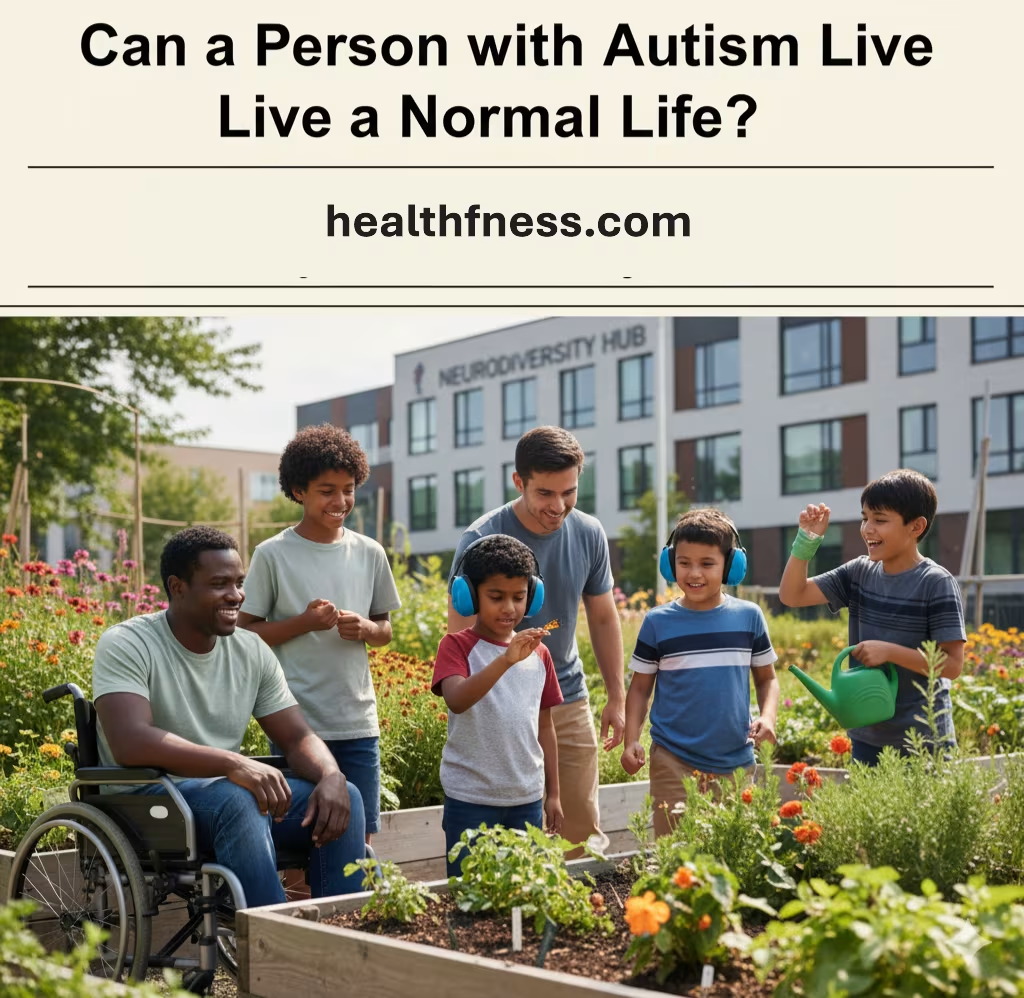For parents of a newly diagnosed child, or for an adult just receiving a diagnosis, one question often looms largest: Can a person with autism live a normal life? This question is born from love, concern, and the uncertainty of navigating a world that isn’t always built for neurodiversity. The short answer is an emphatic yes. However, the concept of a “normal” life is deeply personal and subjective. A more accurate and empowering question might be: Can a person with autism live a full, meaningful, and independent life? To that, the answer is also a resounding yes.
Autism Spectrum Disorder (ASD) is a complex neurodevelopmental condition that affects communication, social interaction, and behavior. As the term “spectrum” implies, it manifests in a wide variety of ways, with each individual having a unique set of strengths and challenges. Debunking the myth that autism is a barrier to a happy life is crucial. With the right support systems, early interventions, and a societal shift towards acceptance, autistic individuals can and do thrive in all aspects of life, from building successful careers and nurturing deep relationships to pursuing their passions with vigor.
This comprehensive guide will explore the realities of living with autism, backed by the latest scientific research and expert insights. We will redefine what a “normal” life can mean, examine the factors that contribute to a high quality of life, and provide practical strategies for autistic individuals and their families to navigate their journey with confidence and hope.
Redefining “Normal”: What Does a Fulfilling Life with Autism Look Like?
The very idea of a “normal life” is a myth. Every person’s journey is unique. For the autistic community, it’s more productive to focus on goals like well-being, independence, and personal fulfillment. A fulfilling life for an autistic person might look similar to that of a neurotypical person, a career, a family, hobbies or it might look entirely different, and both are equally valid.
The key is to understand that autism is not a monolithic condition. The Diagnostic and Statistical Manual of Mental Disorders (DSM-5) categorizes autism by levels of support needed, which provides a clearer picture than outdated and often misleading terms like “high-functioning” or “low-functioning.”
- Level 1: Requiring Support. Individuals at this level may have social communication challenges that are not obvious without support in place. They may struggle with initiating social interactions and find it difficult to switch between activities. They can often live independently but may benefit from social skills training and therapies to manage anxiety or organizational challenges.
- Level 2: Requiring Substantial Support. Social interactions are more challenging for individuals at Level 2. They have marked difficulties with verbal and nonverbal communication, and their interests may be narrow and repetitive. They require more structured support in their daily lives to function in school, work, and the community.
- Level 3: Requiring Very Substantial Support. Individuals at Level 3 have severe challenges with communication and social interaction. They may be nonverbal or have very limited speech. Their repetitive behaviors often interfere with daily functioning. They typically require significant, ongoing support in all aspects of life, often including 24-hour care to ensure their safety and well-being.
Understanding these levels helps tailor support to individual needs, paving the way for each person to reach their maximum potential and define their own version of a successful life.
Key Factors that Shape the Lives of Autistic Individuals
Several critical factors influence an autistic person’s ability to live an independent and fulfilling life. These elements work together to form a robust foundation for growth, learning, and well-being.
The Power of Early Diagnosis and Intervention
Decades of research have shown that early diagnosis and intervention are the most important tools for improving long-term outcomes for autistic children. The American Academy of Pediatrics recommends that all children be screened for developmental delays at 9, 18, and 24 or 30 months. When signs of autism are detected early, specialized therapies can begin during a critical period of brain development.
Evidence-based interventions include:
- Applied Behavior Analysis (ABA) Therapy: ABA is a highly structured therapy that uses positive reinforcement to teach skills and reduce challenging behaviors. It can improve communication, social, and learning skills.
- Speech Therapy: This therapy addresses challenges with both verbal and nonverbal communication. A speech-language pathologist can help with understanding language, expressing needs, and navigating social nuances like tone of voice and body language.
- Occupational Therapy (OT): OT helps individuals develop the skills needed for daily living, from fine motor skills like writing to self-care tasks like dressing. It also plays a vital role in addressing sensory sensitivities, helping individuals learn to regulate their responses to overwhelming stimuli like loud noises or bright lights.
The Role of Co-Occurring Conditions
It’s crucial to recognize that many autistic individuals also have co-occurring medical and mental health conditions. Properly managing these conditions is essential for overall health and quality of life. Common comorbidities include:
- Epilepsy: Seizure disorders are significantly more common in the autistic population, affecting up to a third of individuals, compared to 1-2% of the general population.
- Gastrointestinal (GI) Issues: Chronic constipation, abdominal pain, and food sensitivities are nearly eight times more common in autistic children.
- Mental Health Disorders: Anxiety and depression are prevalent. Research indicates that up to 42% of autistic people experience anxiety disorders, while depression affects 26% of autistic adults compared to 7% of neurotypical adults. Attention-Deficit/Hyperactivity Disorder (ADHD) also frequently co-occurs with autism.
- Sleep Disorders: Over half of autistic children have chronic sleep problems, such as difficulty falling or staying asleep, which can impact behavior, learning, and family well-being.
An integrated healthcare approach that addresses both autism and these co-occurring conditions is fundamental to supporting a long and healthy life.
Education and Employment Opportunities
Inclusive education and supportive employment are pillars of an independent adult life. In school settings, an Individualized Education Program (IEP) is a legal document that outlines the specific accommodations and services a student with a disability needs to succeed academically. This can include extra time on tests, access to a quiet space, or support from a special education teacher.
Transitioning from school to the workforce can be challenging. However, many companies are now recognizing the value of neurodiversity. Autistic employees often bring exceptional skills like intense focus, attention to detail, pattern recognition, and loyalty. Supported employment programs, vocational training, and workplace accommodations (like noise-canceling headphones or flexible schedules) can help autistic adults find and maintain meaningful careers.
The Importance of a Strong Support System
No one thrives in isolation. A strong network of support from family, friends, and the community is vital. For families, this means providing a stable, loving environment while also advocating for their child’s needs in healthcare and educational systems. For the community, it means creating inclusive spaces, from sensory-friendly events at museums to quiet hours at grocery stores, where autistic individuals feel welcome and understood.
Thriving with Autism: Strengths, Success, and Unique Perspectives
Focusing solely on the challenges of autism does a great disservice to the millions of autistic people who contribute to our world in profound ways. Many individuals on the spectrum possess remarkable strengths that stem directly from their unique neurotype.
Common strengths can include:
- Deep Focus: The ability to concentrate on a single task for long periods, leading to expertise in specialized fields.
- Attention to Detail: Meticulous and precise, making them invaluable in roles requiring accuracy, such as data analysis, science, and quality control.
- Systematic Thinking: A strong ability to identify patterns and understand complex systems, a skill essential in programming, engineering, and mathematics.
- Honesty and Directness: A straightforward communication style that is valued for its transparency and sincerity.
- Unique Creativity: A different way of seeing the world can lead to innovative ideas and out-of-the-box solutions.
History and modern society are filled with successful individuals who are or were believed to be on the autism spectrum, including scientist Dr. Temple Grandin, actor Sir Anthony Hopkins, and entrepreneur Elon Musk. Their achievements highlight that an autistic mind is not a deficient one, but a different one, fully capable of greatness.
Navigating the Challenges: Health, Safety, and Life Expectancy
While an autistic person can live a full life, it is important to address the real challenges that can impact health and longevity. Understanding these risks is the first step toward mitigating them.
Understanding Autism Life Expectancy
The topic of life expectancy is sensitive but critical. For years, studies suggested a significantly shorter lifespan for autistic individuals. However, this data was often skewed by including only those with severe co-occurring conditions or by studying populations before modern interventions became widespread.
A landmark study published in The Lancet Regional Health – Europe in 2023 provided a much more hopeful and accurate picture. Analyzing data from the UK between 1989 and 2019, researchers (O’Nions et al.) found that the life expectancy for autistic people without intellectual disabilities was much closer to the general population:
- Autistic Men: 72 to 75 years
- Autistic Women: 70 to 77 years
It’s crucial to understand that autism itself is not a life-threatening condition. The reduced life expectancy seen in some studies is primarily due to associated factors:
- Co-occurring Medical Conditions: As mentioned earlier, conditions like epilepsy can increase mortality risk if not properly managed.
- Accidents: A 2017 study by Guan and Li in the American Journal of Public Health found that individuals with autism were three times more likely to die from unintentional injuries. Drowning is a particularly high risk, often linked to wandering (elopement) behavior.
- Suicide: Social isolation, bullying, and the immense effort of “masking” (hiding autistic traits to fit in) can take a severe toll on mental health. Autistic adults are at a significantly higher risk of suicidal thoughts and attempts.
These findings underscore the urgent need for better healthcare, safety planning (like swimming lessons and tracking devices), and mental health support for the autistic community.
Addressing Healthcare Disparities
Autistic individuals often face significant barriers to receiving quality healthcare. A doctor’s office can be a sensory nightmare, with bright fluorescent lights, loud noises, and long waits. Communication challenges can make it difficult for an autistic person, especially someone who is nonverbal, to describe their symptoms. This can lead to medical issues being misinterpreted as behavioral problems, resulting in missed or delayed diagnoses. Training healthcare professionals to understand autism and make simple accommodations, like providing a quiet waiting area or using visual aids for communication, can dramatically improve health outcomes.
What the Latest Research Says (2023-2024 Updates)
The field of autism research is constantly evolving, bringing new hope and understanding. Staying informed about the latest findings is key for families and individuals.
- Prevalence: The CDC’s 2023 report indicates that approximately 1 in 36 children in the United States is diagnosed with ASD. This increase is believed to be due to better diagnostic practices and greater awareness, not an actual rise in the condition’s occurrence.
- Life Expectancy: The O’Nions et al. (2023) study is a game-changer, challenging outdated, pessimistic views on lifespan and highlighting the impact of supportive care and diagnosis.
- Mental Health: Ongoing research continues to highlight the strong link between autism and mental health conditions like anxiety. This has led to the development of adapted therapies, such as Cognitive Behavioral Therapy (CBT) modified specifically for autistic individuals, which have shown promising results in managing anxiety.
- Genetics: Scientists continue to identify genes associated with autism, confirming it is a strongly genetic condition. This research aims to understand the biological mechanisms of autism, which could lead to more targeted and effective future therapies.
Support Needs Across the Autism Spectrum (DSM-5 Levels)
To better visualize the diversity of the autism spectrum, this table breaks down the three DSM-5 support levels.
| Support Level | Social Communication Challenges | Restricted, Repetitive Behaviors (RRBs) | Example of Support Needed |
|---|---|---|---|
| Level 1: Requiring Support | Difficulty initiating social interactions; atypical or unsuccessful responses to others. May seem to have decreased interest in social interactions. | RRBs cause significant interference with functioning in one or more contexts. Resists attempts by others to interrupt RRBs or to be redirected. | Therapy to develop social skills; support with organization and planning; accommodations in school or the workplace. |
| Level 2: Requiring Substantial Support | Marked deficits in verbal and nonverbal social communication skills. Social impairments are apparent even with supports in place. Limited initiation of social interactions. | RRBs are obvious to the casual observer and interfere with functioning in a variety of contexts. Distress or frustration appears when RRBs are interrupted. | Structured social skills training; specialized educational programs; daily assistance with some life skills; visual supports. |
| Level 3: Requiring Very Substantial Support | Severe deficits in verbal and nonverbal communication skills cause severe impairments in functioning. Very limited initiation of social interactions and minimal response to social overtures from others. | Preoccupation with RRBs, which markedly interfere with functioning in all spheres. Marked distress when rituals or routines are interrupted. | Intensive, often one-on-one therapy; 24/7 supervision or care; assistance with all daily living activities; augmentative and alternative communication (AAC) devices. |
Practical Strategies to Support a Fulfilling Life for Autistic Individuals
Building a supportive environment is a collective effort. Here are actionable tips for parents, autistic adults, and the wider community.
For Parents and Caregivers
- Become the Expert on Your Child: Learn their unique triggers, comforts, and communication styles. Your knowledge is their best advocacy tool.
- Focus on Strengths: Nurture your child’s passions. If they love dinosaurs, fill their world with dinosaur books, museums, and documentaries. This builds confidence and can even lead to a future career.
- Advocate Tirelessly: Fight for the right educational placements (IEPs), therapies, and healthcare. You are your child’s most powerful voice.
- Prioritize Safety: If your child is prone to wandering, implement a safety plan. This may include alarms on doors, a wearable GPS tracker, and swimming lessons.
- Practice Self-Care: Caring for an autistic child can be demanding. It’s not selfish to take care of your own mental and physical health; it’s essential. Join a support group to connect with other parents.
For Autistic Adults
- Embrace Your Identity: Learning about autism and connecting with the autistic community can be incredibly empowering. You are not broken; your brain is simply wired differently.
- Leverage Your Strengths: Identify what you excel at and seek educational paths or careers that play to those strengths.
- Build Your Support Network: This can include trusted family members, friends, therapists, and mentors. You don’t have to navigate life alone.
- Advocate for Your Needs: Don’t be afraid to ask for reasonable accommodations at work or in college, such as written instructions, a quieter workspace, or more time for assignments.
- Manage Sensory and Mental Health: Develop strategies to cope with sensory overload, such as using noise-canceling headphones or taking breaks. Seek therapies like CBT if you are struggling with anxiety or depression.
For Society and Employers
- Educate Yourself: Move beyond stereotypes. Learn about autism from autistic people themselves by reading blogs, books, and following advocates on social media.
- Create Inclusive Environments: Simple changes can make a world of difference. Offer sensory-friendly hours, provide clear signage, and train staff to interact with patience and understanding.
- Rethink Hiring Practices: Traditional interviews that rely heavily on unspoken social cues can screen out highly qualified autistic candidates. Consider skills-based assessments and structured interview questions.
- Promote Neurodiversity: Foster a culture of acceptance and celebrate the unique contributions of all employees. A diverse workforce is an innovative and resilient workforce.
Frequently Asked Questions About Living with Autism
Can a person with autism get married and have a family?
Absolutely. Many autistic individuals desire and form loving, long-lasting relationships, get married, and have children. While navigating the social complexities of dating and relationships can present unique challenges, success is entirely possible, especially with open communication and mutual understanding between partners.
Does autism affect life span directly?
No, autism itself is a neurodevelopmental condition, not a disease that shortens one’s life. The lower life expectancy sometimes reported is not caused by autism itself but by associated risks like co-occurring medical conditions (e.g., epilepsy), higher rates of accidents (like drowning), and increased suicide risk due to mental health challenges.
What jobs are good for autistic people?
There is no single “best job.” The ideal career depends on the individual’s unique strengths, interests, and support needs. Many autistic people excel in fields that require strong attention to detail, pattern recognition, and deep focus, such as IT, software development, data analysis, scientific research, accounting, library science, and animal care. However, autistic people can be found in every profession imaginable.
Can autism be cured?
No, autism is not an illness or disease to be “cured.” It is a lifelong neurodevelopmental difference. The goal of therapies and support is not to eliminate autism but to help individuals develop skills, manage challenges, and improve their quality of life so they can thrive as their authentic, autistic selves.
Why is early intervention so important for autism?
Early intervention is crucial because a young child’s brain has high “plasticity,” meaning it is very adaptable. Starting therapies like ABA, speech, and occupational therapy during the toddler and preschool years can have a profound impact on developing communication, social, and cognitive skills, which sets a stronger foundation for lifelong learning and independence.
Conclusion
So, can a person with autism live a normal life? The answer is clear: they can live so much more. By shifting our perspective from “normal” to “fulfilling,” we open up a world of possibilities. An autistic life can be a life rich with deep interests, loyal friendships, meaningful work, and profound love. The journey may have more obstacles than a neurotypical path, but it is no less valid or worthy.
Success depends on a combination of factors: early and consistent evidence-based support, management of co-occurring conditions, robust family and community networks, and a societal commitment to inclusion and acceptance. By focusing on an individual’s strengths, providing the right tools, and fostering a world that values all kinds of minds, we can ensure that every autistic person has the opportunity not just to live, but to flourish.
References
- Centers for Disease Control and Prevention (CDC). (2023). Data & Statistics on Autism Spectrum Disorder.
- O’Nions, E., et al. (2023). Estimating life expectancy and years of life lost for autistic people in the UK: a matched cohort study. The Lancet Regional Health – Europe, 35, 100776.
- Guan, J., & Li, G. (2017). Injury mortality in individuals with autism. American Journal of Public Health, 107(5), 791–793.
- World Health Organization (WHO). (2023). Autism.
- National Institute of Mental Health (NIMH). Autism Spectrum Disorder.
- Mayo Clinic. Autism spectrum disorder.

Dr. Mark Jenkins, MD - General Physician (California, USA)
Dr. Mark Jenkins is a board-certified general physician based in the United States, specializing in preventive medicine, nutrition, and lifestyle health. With years of clinical experience in primary care, he is dedicated to helping patients and readers alike make informed, science-based decisions about their well-being.
As a trusted medical reviewer and contributor to Healthfness.com, Dr. Jenkins ensures that all health content meets the highest standards of accuracy, safety, and evidence-based medicine. His expertise bridges modern medical science with practical, everyday wellness strategies, making complex topics approachable for all audiences.
Outside the clinic, Dr. Jenkins is passionate about living the healthy lifestyle he teaches. He enjoys hiking with his dog, experimenting with vegetarian cooking, and exploring the latest health research. He believes that small, consistent lifestyle changes lead to lasting health improvements, and he aims to inspire readers to take proactive steps toward a healthier, happier life.
Explore more of Dr. Jenkins’ evidence-based insights at Healthfness.com



